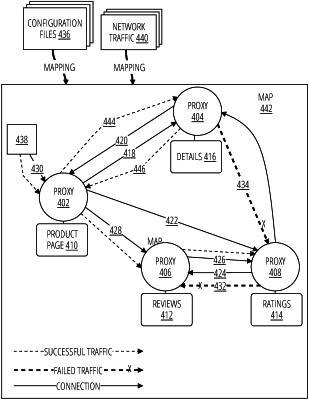| CPC H04L 41/12 (2013.01) [H04L 67/56 (2022.05)] | 20 Claims |

|
1. A method, comprising:
obtaining, by a processing device, a configuration file of each of a plurality of proxies;
parsing, by the processing device, the configuration file of each of the plurality of proxies to determine one or more connections for each of the plurality of proxies including parsing the configuration file to determine where a respective one of the plurality of proxies is configured to route data to or accept the data from as defined by the configuration file, each connection supporting incoming or outgoing communication for each of the plurality of proxies;
parsing, by the processing device, network traffic of the plurality of proxies to determine incoming or outgoing communication of each of the plurality of proxies; and
generating, by the processing device, a map that comprises the one or more connections for each of the plurality of proxies, including generating a first node for a first of the plurality of proxies and a second node for a second of the plurality of proxies, generating a first edge between the first node and the second node wherein the first edge indicates a direction of expected data flow in accordance with how the configuration file defines where the first or the second of the plurality of proxies is configured to route the data to or accept the data from, and in response to the network traffic being between the first of the plurality of proxies and the second of the plurality of proxies, generating a second edge between the first node and the second node having a directional indicator indicating a direction of the network traffic between the first of the plurality of proxies and the second of the plurality of proxies, wherein the first edge and the second edge are presented between the first node and the second node as being visually different.
|